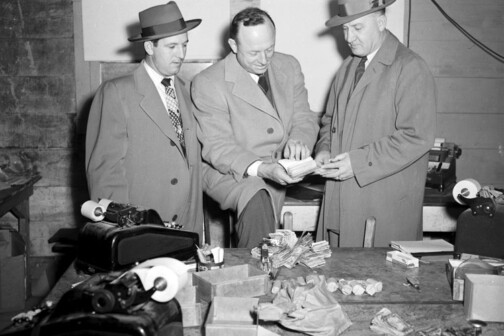The recent history of Texas could be told in the story of the taco.
I’ve been thinking about that in the wake of the minor blunderbuss that went off after we published our September “Taco City” cover, which prompted the good people of San Antonio to have a conniption on Twitter. How dare Dallas declare its taco dominance! San Antonio is the great mecca of Texas Hispanic heritage.
Well, sure. It is. But implicit in Dallas’ taco ascendancy is a hidden story about how urbanization and immigration are profoundly changing the culture and character of the city and the state.
San Antonio—once the capital of the Spanish, and later the Mexican, province of Tejas—is the long-established epicenter of the collision of Texan and Mexican culture. It is the birthplace of the chili parlor and the cultural heart of Tex-Mex cuisine. And even though Dallas has some Hispanic families who can trace their roots back to the waves of immigrants who moved to Texas during the Mexican Revolution, this city had a justified reputation for having long served up gringo-ized Tex-Mex. Dallas’ Mexican food has generally been blander and less adventurous than what you would find in the rest of Texas. Its culinary roots lie with high-end steakhouses and heartier chuckwagon fare like chicken-fried steak.
Historically, Dallas’ Hispanic population could not compare with San Antonio’s. According to a 2016 study by Habitat for Humanity, in 1970, only 7.5 percent of Dallas’ population was Hispanic. Over the past few decades, however, those numbers have changed dramatically. Dallas County has outpaced Bexar County in terms of its annual share of Texas immigration.
Between 2010 and 2014, 70.9 percent of the population increase in the DFW Metropolitan Statistical Area (MSA) has been driven by foreign-born immigrants, the majority of them Hispanic, while only 40 percent of the increase of the San Antonio-New Braunfels MSA has been driven by foreign-born immigrants. From 1970 to 2010, the Hispanic population in Dallas grew from 7.5 to 42 percent of the city’s population. By comparison, in 2010, Hispanics in San Antonio made up 63.2 percent of the population. In other words, Dallas is catching up to the former Spanish presidio.
The character of the growth in Dallas’ Hispanic population plays into the taco conversation in two significant ways. The first has to do with perception. Coming from the land of the puffy taco, the average San Antonian hasn’t ventured into Oak Cliff or East Dallas in pursuit of the perfect al pastor. If the reaction to the September cover is any indication, the perception of Dallas in the rest of the state is still mostly Cowboys Cheerleaders and swashbuckling JRs; a Dallas taco is likely imagined as an under-seasoned scoop of ground beef dripping from a crispy yellow shell.
But that isn’t the city Dallas is today, and those aren’t the tacos we eat. In a relatively short time, Dallas has evolved into a more richly diverse and culturally vibrant city than it has ever been.
The second way the quick growth of Dallas’ Hispanic population plays into the taco debate is outlined in our writer José Ralat’s brilliant September cover story. (You can buy it on newsstands now or wait until next Tuesday when it publishes online.) What makes Dallas taco culture so vibrant and interesting is that it draws liberally from a great variety of regions and styles. There is no “Dallas taco,” and in a certain sense Dallas doesn’t have much of a taco culture that is indigenous to the city. Rather, Dallas is the great beneficiary of being the landing place of so many immigrants from so many different parts of Mexico. The city’s taco scene has a multiplicity of regional styles and ingredients. San Antonians can turn their noses up at Dallas, but until they have sat down and eaten recent Mexico City transplant Rodolfo Jimenez’s tres coleres tacos at Maskaras Mexican Grill, or the Tijuana-inspired pulpo taco at Tacos Mariachi, they have no ground to criticize Dallas’ taco scene. That scene is rich precisely because its local culinary tradition is relatively shallow; its taco roots still stretch back into the dirt of the old country.
But I hope the native Texans will forgive me if I also defend Dallas’ taco cred by making a comparison to New York, where I grew up. A few weeks ago, someone in the office asked me if I thought such-and-such place in Manhattan served the best New York pizza. The question struck me as patently ridiculous, not because the place in question did or didn’t serve good pizza (I had never been there), but because the entire idea of “the best pizza in New York” doesn’t make any sense.
New York is a pizza town—the pizza town. There is a ridiculous amount of great pizza in New York, but no matter where you go in New York, you can always find a good slice of pizza. Everyone has their favorite places. If I’m taking an out-of-towner out for pizza, I’ll probably go to Arturo’s on Houston or John’s on Bleecker. But when I’m back home, I’m just as likely to crave places like Piccolo’s out on Long Island. It’s also what drives me crazy when people talk about the “best bagels in New York.” Give me a break. What’s great about New York is that you can always get a great bagel no matter where you are.
I feel the same way about tacos in Dallas. I moved here in 2002, and as long as I’ve lived in Dallas, I have lived in Oak Cliff. Tacos are a staple of my diet. I eat tacos at least once a week, if not more. Whenever I leave the state, I make sure to eat a few tacos before I get on the plane. When I get back, tacos welcome me home. I have my places. Some of them are on the list of the best tacos in Dallas that we published. Some of them aren’t.
I’ve long been using José Ralat’s blog, his other features, and now his latest piece for D to expand my taco palate. I believe he is one of the great Texas food writers—alongside Robb Walsh and Daniel Vaughn—who are doing important work in documenting and preserving the rich culinary history of the state. But I’m just as likely to crave a taco joint on Ralat’s list as I am to swing by the since-closed Valero station at the corner of I-30 and Sylvan Ave., which served up some pretty solid and reliable no-nonsense street tacos before 7-Eleven bought the property. Were they the best tacos in the world? No. But they were damned good.
And that’s why Dallas is a great taco city. Because the bar for good tacos is high across the board. So high, that I believe Dallas can go toe to toe with any other Texas city. Sure, saying that might prick some local pride and raise some eyebrows. But that’s because Texas is changing — both the tacos and the state.





